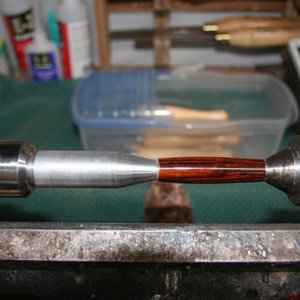jrich7970
Member
Hi guys. New to all this, only on my third pen, so I realize I have no experience, but perhaps you could give me a few tips. I've started with the slimline, which I have read is where a lot of people start.
My issues so far have been with finishing. But the issues don't seem to be what most of the posts I see are about, but I bet a lot of you have had similar problems. I'm posting some pictures and will describe what went on.

So this was my first effort. The wood was perfectly smooth, but, after I finished and put the pen together, I noticed these marks running diagonally. I now know to inspect the blanks before I assemble the pen, but how did these get on an angle? I know it's too late for this pen now, and fortunately it only cost me less than $5 for this mistake, but if I can avoid it in the future, that would be particularly awesome. I can detail what I did with regard to application, sanding, etc.

My second one was perhaps even worse. I noticed the diagonal ridges again, and sanded down almost to bare wood and started over on the CA again. But it looks like I put soooo much on that it built up increased the size of the pen. I swear that the wood was perfectly sized to the bushings before I started the CA.
There are other problems I had, but I can go into them later.
I have a third pen I've turned, but I'm almost afraid to finish it because it so darn beautiful and smooth as glass. I'm afraid to mess it up. But, in reality, I also need to get a grip...it's only a $3 blank.
My intention is to grab a hunk of spare wood I have laying around, turn it smooth, then start with the CA. Sand it off (or turn it off), try again. Sand it off, try again. Over and over until I figure it out.
Any help would be appreciated!
Thanks,
Jeff
My issues so far have been with finishing. But the issues don't seem to be what most of the posts I see are about, but I bet a lot of you have had similar problems. I'm posting some pictures and will describe what went on.
So this was my first effort. The wood was perfectly smooth, but, after I finished and put the pen together, I noticed these marks running diagonally. I now know to inspect the blanks before I assemble the pen, but how did these get on an angle? I know it's too late for this pen now, and fortunately it only cost me less than $5 for this mistake, but if I can avoid it in the future, that would be particularly awesome. I can detail what I did with regard to application, sanding, etc.
My second one was perhaps even worse. I noticed the diagonal ridges again, and sanded down almost to bare wood and started over on the CA again. But it looks like I put soooo much on that it built up increased the size of the pen. I swear that the wood was perfectly sized to the bushings before I started the CA.
There are other problems I had, but I can go into them later.
I have a third pen I've turned, but I'm almost afraid to finish it because it so darn beautiful and smooth as glass. I'm afraid to mess it up. But, in reality, I also need to get a grip...it's only a $3 blank.
My intention is to grab a hunk of spare wood I have laying around, turn it smooth, then start with the CA. Sand it off (or turn it off), try again. Sand it off, try again. Over and over until I figure it out.
Any help would be appreciated!
Thanks,
Jeff

